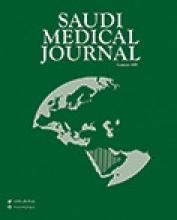Abstract
OBJECTIVE: To study enterococcal blood stream infection including the different species isolated, their antibiotic resistance associated risk factors and outcome of treatment.
METHODS: A retrospective and prospective study was carried out over a 12 month period between June 2001 and May 2002 in King Khalid University Hospital, Riyadh, Kingdom of Saudi Arabia. Sixty episodes of enterococcal bacteremia with clinical significance detected in adults and neonates were included. Statistical analysis of the epidemiological characteristic, etiologic risk factors and mortality were determined.
RESULTS: Fifty-four (90%) of the episodes were hospital acquired. Fifty-five percent of patients were elderly males and 20% were neonates. Patients usually have severe underlying diseases (57%) and the mortality rate was 28%. The estimated duration of hospital stay after acquiring the Enterococcal bacteremia was 40 days. The source of bacteremia remained undetermined in 72% of the episodes. Gastrointestinal tract, urinary tract and intravascular catheter were the most frequently recognized associated sites of infection. Thirty-three patients (55%) had previously received antimicrobial agents (mainly cephalosporins). In this study, intravascular catheter (p=0.0002), urinary catheter (p=0.00001), mechanical ventilation (p=0.002), previous surgery (digestive tract surgery (p=0.01) and prior stay in an intensive care unit (p=0.03) were the factors associated with Enterococcal bacteremia and mortality.
CONCLUSION: Efforts to reduce the occurrence of enterococcal bacteremia should be focused on appropriate use of cephalosporins and external devices.
- Copyright: © Saudi Medical Journal
This is an open-access article distributed under the terms of the Creative Commons Attribution-Noncommercial-Share Alike 3.0 Unported, which permits unrestricted use, distribution, and reproduction in any medium, provided the original work is properly cited.






